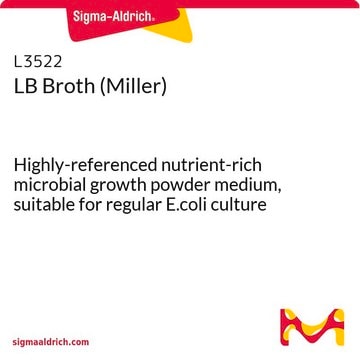C4478
S-Gal®/LB Agar-Mischung
reagent for selection of recombinant bacterial clones
Synonym(e):
Agar Blend
About This Item
Empfohlene Produkte
Qualität
for molecular biology
Sterilität
non-sterile
Form
powder
Methode(n)
microbiological culture: suitable
Eignung
suitable for β-galactosidase test
nonselective for Escherichia coli
nonselective for coliforms
Anwendung(en)
food and beverages
microbiology
Lagertemp.
room temp
Verwandte Kategorien
Allgemeine Beschreibung
Anwendung
Leistungsmerkmale und Vorteile
- More intense color contrast than X-gal
- Water-soluble and autoclavable for easiest use
- Convenient, pre-mixed media
Komponenten
Trypton, 10
Hefeextrakt, 5
Natriumchlorid, 10
Agar, 12
S-Gal, 0.3
Eisen(III)-ammonium-citrat, 0.5
IPTG, 0.03
Prinzip
Angaben zur Herstellung
Sonstige Hinweise
formulation. A medium prepared with S-Gal® is moderately dark due to the presence of ferric ammonium citrate. This darker background often provides enhanced contrast for automated colony counting or isolation.
Rechtliche Hinweise
Ähnliches Produkt
Lagerklassenschlüssel
11 - Combustible Solids
WGK
WGK 3
Flammpunkt (°F)
Not applicable
Flammpunkt (°C)
Not applicable
Persönliche Schutzausrüstung
Eyeshields, Gloves, type N95 (US)
Analysenzertifikate (COA)
Suchen Sie nach Analysenzertifikate (COA), indem Sie die Lot-/Chargennummer des Produkts eingeben. Lot- und Chargennummern sind auf dem Produktetikett hinter den Wörtern ‘Lot’ oder ‘Batch’ (Lot oder Charge) zu finden.
Besitzen Sie dieses Produkt bereits?
In der Dokumentenbibliothek finden Sie die Dokumentation zu den Produkten, die Sie kürzlich erworben haben.
Kunden haben sich ebenfalls angesehen
Unser Team von Wissenschaftlern verfügt über Erfahrung in allen Forschungsbereichen einschließlich Life Science, Materialwissenschaften, chemischer Synthese, Chromatographie, Analytik und vielen mehr..
Setzen Sie sich mit dem technischen Dienst in Verbindung.







